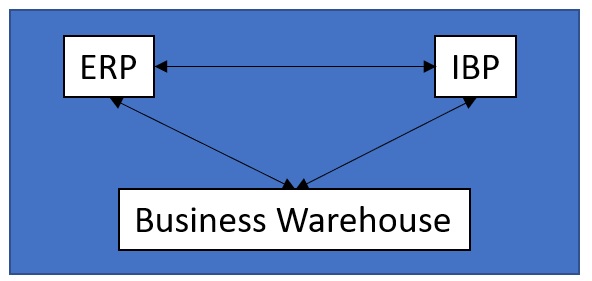How Business Warehouse can help you in IBP Projects
Introduction and Motivation
Currently, there are different projects related to Integrated Business Planning ongoing. One motivation could be to have a successor for APO (Advanced Planning and Optimization).
In case your system landscape contains a Business Warehouse system, you might be interested on how to utilize it in your IBP Projects. This question is exactly the scope of this blog.
Architecture
Reference Data for IBP
Most likely, the IBP system will have a direct connection to your ERP system for synchronization of some master data and some other things. When it comes to special requirements, the ERP system might not be the best source system to take and you will not be able to extract data in a granularity which can be digested by IBP. Let’s think about the requirement to aggregate the reference data along a customer planning hierarchy. Instead of reinventing the logic in ERP or in IBP, you might like to reuse it from existing planning applications in Business Warehouse. This is just one example. You will have more harmonization and aggregation requirements for different areas of reference data in your project. For such cases, Business Wareshouse can be a very helpful system.
Most likely the level of detail for IBP will be something like:
• Planning Customer
• Planning Material
• Calender Year
• Calender Month
• Plant
• Sales Organization
• Version
• Quantity
The reference data might be on a very different level and it can be very painful to bring all data to a proper granularity without a Business Warehouse.
Some data might only be available in Business Warehouse, like external data from the market which you would like to use for your planning process.
Backwards Integration to ERP
But not only the integration of reference data is required. You will also most likely find the requirement to write data back from IBP to ERP. Let’s take the COPA Module as an example and the retraction transactions KELC and KELR. You can’t use those transactions in ERP together with IBP directly, as IBP does not allow you to implement BEx Queries.
You could use the Business Warehouse again to write data back from IBP to an aDSO in Business Warehouse first and consume it via BEx Queries and utilize the ERP transactions you already might have in place.
SAP Cloud Platform Integration for Data Services (CPI-DS)
Most probably you will also find CPI-DS in your IBP project. CPI-DS can be used to read e.g. the aDSO table, where you put the reference data in. It can also be used to trigger the loading process of the results of IBP into Business Warehouse.
On a very high level your architecture could look like the one in the following picture.

Summary
During the project preperation, it is very helpful to list all sources which should be integrated to support the process inside IBP. It might be helpful to use an existing Business Warehouse to collect, harmonize and aggregate the data to the needed granularity for IBP.
Be prepared for interfaces. Don’t underestimate the effort to connect the systems and the integration between the systems.
Make sure you have clean master data and harmonized processes.